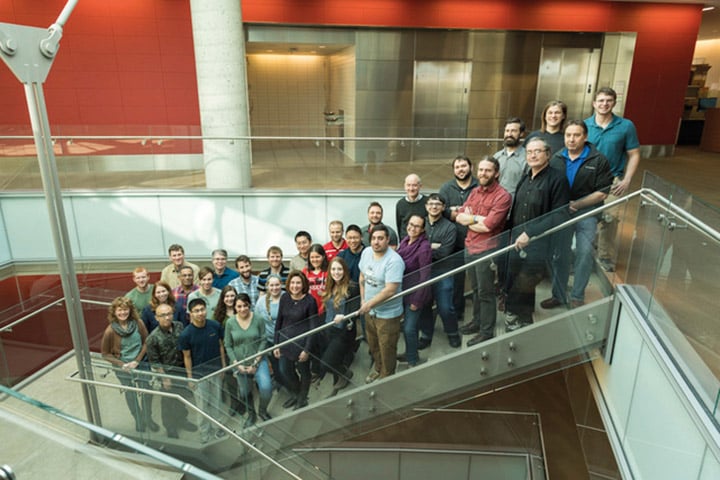Stem cells offer the potential to revolutionize the treatment of many currently incurable conditions, as well as providing invaluable research tools to further our understanding of biological processes. Since stem cell pioneer Dr James Thomson derived the first human embryonic stem cell line in 1998, this has grown into a whole new field of biology. Dr Thomson and his team at the Morgridge Institute for Research are still at the forefront of this research, using their vast knowledge and experience to develop novel therapeutic approaches and tackle many of the unanswered questions in developmental biology.
The Morgridge Institute for Research in Wisconsin is home to a wide array of scientific disciplines, from regenerative biology to medical engineering and high throughput computing. Major discoveries in the Thomson Lab over the last two decades have propelled the Morgridge Institute to a world-leading position in the field of stem cell and regenerative biology. This remains the focus of the lab today, as Chris Barry, a former researcher in the Thomson Lab who now works for the International Society for Stem Cell Research, explained: “The Thomson Lab’s work encompasses a broad spectrum of stem cell-based research. On one hand, they’re using stem cells to try and understand the biological underpinnings of cell development while, on the other, they’re investigating how this knowledge could be translated into therapeutic approaches that are ultimately intended for the clinic. For example, the lab has investigated the timing mechanisms underpinning different mammalian gestation periods, looking at the differences between species – such as a mouse and a human.1 It’s almost a complete mystery what determines the intrinsic rate of differentiation of cells, and the slow pace of human cell development is currently one of the limitations of stem cell-based therapies; it takes a long time to produce specialized mature cells. If we can understand the mechanism governing this developmental clock, we could potentially speed it up to produce these therapies in a more clinically-relevant timeframe.”

The Thomson Lab brings together expertise from across the field of stem cell and regenerative biology
“The knowledge gained from this work feeds into the lab’s other research as well, where one of the major areas of interest is vascular biology, as cardiovascular disease is the world’s leading cause of mortality. For instance, vascular grafts have a lot of therapeutic potential but, unfortunately, many patients experience rapid progression of disease into these grafts following surgery. The lab is therefore investigating how to differentiate stem cells into specialized blood vessel cells that can resist this deterioration and avoid rejection by the immune system. Alongside this work, the lab is also exploring stem cell-based therapies for a variety of other conditions, such as stroke, liver disease and diabetes.”
Like many stem cell laboratories around the world, the Thomson Lab uses laboratory automation as part of its workflow. Mitchell Probasco, Project Manager of Automation, explained how its Tecan systems are instrumental to the research. “We have a Freedom EVO® workstation with an integrated Infinite® M1000 microplate reader in the lab. These were originally acquired to perform high throughput screening to determine the optimal culture conditions for stem cells, testing different media components and parameters. We soon realized the automation systems were capable of doing far more, and had the idea of using the Tecan system to do time-course experiments investigating differentiation rates.” – sampling every four minutes for 10 hours. This has enabled us to achieve a significantly higher resolution and accuracy – something that would have been impractical or impossible to otherwise attain.”
Automation has been key to this, eliminating the need for manual sampling and allowing us to follow cell differentiation at a temporal resolution that has rarely been achieved before.
“Traditionally these experiments would have involved sampling the cells perhaps once a day at most. However, cellular differentiation is an ongoing process that happens on the scale of minutes, not days, so we wanted to sample the cells more frequently and consistently in order to capture those events. Automation has been key to this, eliminating the need for manual sampling and allowing us to follow cell differentiation at a temporal resolution that has rarely been achieved before capable of analyzing the high frequency longitudinal data we were generating. We therefore developed a novel method called ‘Trendy’, which is also now available for other labs to use.2 Using this approach, it is clear that one of the major advantages of automation is that it reduces background noise in the data. This makes the analysis much cleaner and allows more accurate interpretation, especially for long time-course experiments like these.”
To find out more about Tecan’s cell biology solutions, visit www.tecan.com/cellbiology
To learn more about the work of the Thomson Lab, go to www.morgridge.org/research/regenerative-biology/thomson-lab









